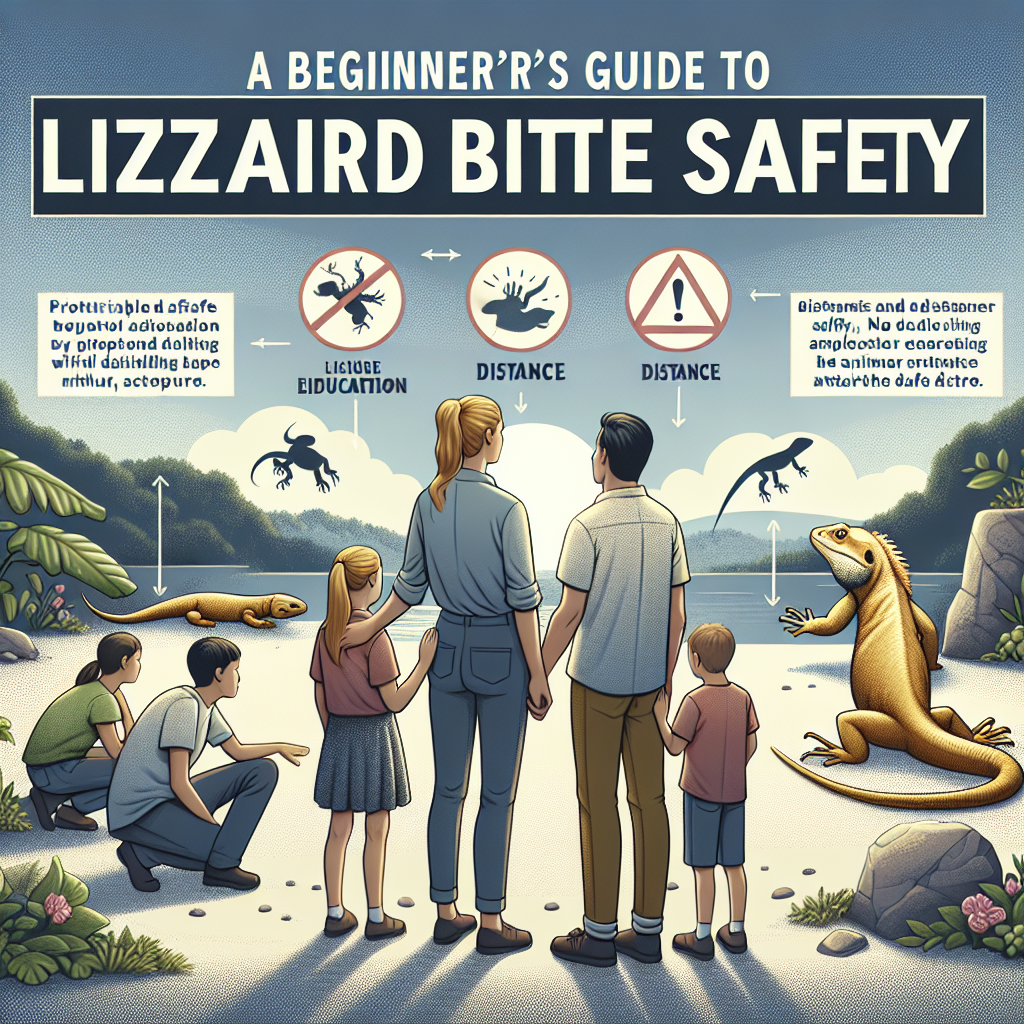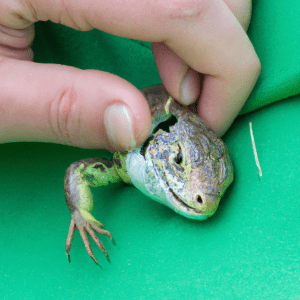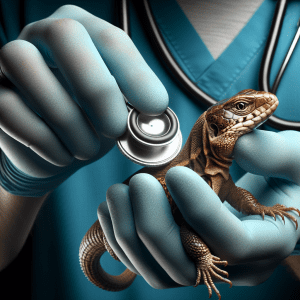Picture this: You're embarking on an exciting family adventure into the wild outdoors. Camping gear? Check. First aid kit? Check. But then you ask yourself, "How prepared am I really for unexpected creature encounters? Take a lizard, for instance – what if it bites?" For many of us, delving into the world of Lizard Bite Safety can seem as daunting as a dense jungle. But fret not, you've bravely explored your way to the right place!
Don't we all love charts uncharted, but hesitate before the unknown, the bits left off the map? Well, consider this your friendly tour guide, eager to help you navigate through this adventure together – because, believe me, knowing about lizard bite safety is as important as remembering to apply sunscreen on a sunny day at the beach.
In this comprehensive guide, we'll start at base camp, explaining the basics and clearing any myths or misconceptions. Then, we'll ascend to identifying common lizard species and their behaviours. Next, it’s about creating a lizard-proof environment – something crucial for family camping trips or excursions to national parks. And of course, we'll also share essential tips on teaching your kids how to interact safely with these fascinating creatures.
And if the unexpected does occur? Don't worry. We have you covered with what to do right after a lizard bite, and when to seek professional help. We're here to make sure you're well-equipped for this journey into nature, because while lizards might not be the most cuddly members of the animal kingdom, they deserve respect and understanding just the same – and so does your family’s safety.
In embarking on this expedition together, you'll emerge better prepared and more confident, giving your family the assurance they need so you can focus on what’s really important – savoring those unforgettable moments nature has to offer. Grab your metaphorical backpack, let's navigate this together!
This Beginner's Guide to Lizard Bite Safety is designed for parents and families eager to explore the great outdoors while ensuring their loved ones stay safe from unexpected creature encounters. We’ll equip you with essential knowledge, from understanding lizard behaviors and creating a lizard-proof environment to teaching your kids how to interact safely with these fascinating reptiles. With practical tips for handling lizard bites and knowing when to seek help, you'll gain the confidence to enjoy nature’s wonders while prioritizing your family's safety.
Understanding the Basics of Lizard Bite Safety
: A Beginner's Guide
Have you ever found yourself caught off guard while hiking, with the sun setting, and your child excitedly pointing at a curious-looking lizard? If so, you're not alone. Many parents feel a bit anxious when it comes to wildlife encounters. But worry not—knowing the basics of lizard bite safety is simpler than you think. Let’s embark on this learning journey together, shall we?
Assessing the Situation
First, take a deep breath and assess the environment. Is this lizard native to the area, or is it an unfamiliar species? While most lizards are harmless, it's essential to keep a safe distance. Encourage your family to enjoy the view without touching the creatures. Imagine it like admiring a work of art from afar—close enough to appreciate but distant enough for both your safety and theirs.
Educate and Equip
Sharing knowledge with your little explorers is crucial. Discuss the importance of lizard bite safety during your travels. Equip your family with simple first aid tools and teach them basic prevention measures. It’s like building a toolkit of confidence, fostering a sense of empowerment rather than fear. After all, prevention is better than cure!
Emergency Preparedness
What if a bite does occur? Stay calm; most bites are not dangerous but can cause irritation. Clean the wound promptly with soap and water. It’s the same care you'd show a simple cut. Keep contact details for medical assistance handy—just like packing an extra pair of socks, it’s better to have it and not need it.
Armed with this knowledge, you're not just a traveler—you're a protector of family adventures. Embrace every journey, secure in knowing that you’ve mastered the steps of lizard bite safety. What's stopping you from being the hero of your next family trip? You're ready—let’s explore safely and confidently!
This Beginner's Guide to Lizard Bite Safety is designed for parents seeking to navigate wildlife encounters with confidence during family outings. By prioritizing awareness, education, and emergency preparedness, the article aims to empower families to appreciate nature while minimizing risks associated with lizard bites. With practical tips and an encouraging approach, parents will learn to keep their loved ones safe and enjoy their adventures worry-free.
Identifying Common Lizard Species and Their Behaviors
Have you ever found yourself staring at a lizard, unsure how to react or what it might do next? Let’s dive into the captivating world of lizards, so you can confidently handle any lizard-related encounters on your travels.
Know the Usual Suspects
The first step to "lizard bite safety" is knowing who you're dealing with. In many travel destinations, you might encounter geckos, iguanas, or anoles. Geckos are small, often with sticky toes that let them cling to walls, while iguanas can be larger and often sport a ridge of spikes down their backs. Anoles usually come in vibrant greens and browns and can change color for camouflage. Recognizing these species can help you anticipate their behaviors and act accordingly.
Understand Their Behavior
Most lizards are harmless and would prefer to avoid you rather than bite. Geckos, for instance, are generally timid and may scurry away, while iguanas can become defensive if they feel cornered. Knowing that an anole's sudden color change is often a sign of stress can help spare both you and the lizard a tense confrontation. Observing lizard behavior can keep you safe and enhance your travel experience.
Scenario Unpacking
Imagine you’re sitting quietly on a tropical veranda when a gecko crosses your path. Instead of panicking, you calmly enjoy its presence, knowing it’s just making its way. This understanding brings a sense of awe, turning a potential fear into a delightful moment. By being informed about the lizard species around you, "lizard bite safety" becomes second nature, allowing you to enjoy your adventures without worry.
Remember, most lizards are more scared of us than we are of them. With a little knowledge, you can appreciate these fascinating creatures while keeping everyone safe. You've got this!
This Beginner's Guide to Lizard Bite Safety is designed for travelers who want to better understand their encounters with lizards and mitigate any fears. By learning to recognize common lizard species and their behaviors, you can transform potentially anxiety-provoking moments into opportunities for appreciation. Remember, with a little knowledge about these creatures, you can navigate lizard-related situations confidently and safely.
Creating a Safe Environment to Prevent Lizard Bites
Imagine setting out on an adventurous family vacation only to realize your little one has had a close encounter of the lizard kind. Don’t worry—creating a lizard-safe environment is simpler than it sounds. Let’s dive in and keep your travels bite-free!
1. Educate Your Family:
Start with the basics: teach your kids what to look out for. Lizards often blend into their surroundings, especially in lush travel spots. Make it a game—like a lizard version of "I-spy"—to help them feel involved and alert without fear.
2. Safe Accommodation Choices:
When booking your stay, look for lizard-repellent measures. Choose locations that prioritize pest control. Remember to ask the hosts about their safety practices regarding wildlife, ensuring a sound sleep for the entire family.
3. Secure Outdoor Play Areas:
Kids love the great outdoors, but always supervise play in areas prone to lizards. Look for enclosed playgrounds, and encourage your children to wear closed shoes. This isn’t just about preventing bites; it’s about creating peace of mind, too.
4. Handle Food and Waste Properly:
Lizards are often attracted to food scraps. Keeping your travel picnic neat can deter these creatures from coming close. Use sealable bags for snacks and ensure waste is promptly disposed of in closed bins.
Creating a lizard-bite-safe environment does more than just prevent little nips. It builds a bubble of security and adventure where your family can explore the world together, worry-free. Isn’t that just what great trips are about? You're not just ready—you’re already on your way to becoming the seasoned family safety expert you aspire to be!
In this Beginner's Guide to Lizard Bite Safety, we aim to empower adventurous families with practical strategies to protect their little ones from unexpected encounters with lizards while traveling. By transforming safety education into a fun game, choosing the right accommodations, supervising outdoor play, and managing food waste properly, families can create a lizard-friendly environment and enjoy worry-free adventures together. With these tips, you’ll be well on your way to ensuring your family stays safe and secure as you explore the great outdoors!
Teach Children How to Respect and Interact with Lizards Safely

Teaching Children How to Respect and Interact with Lizards Safely
Imagine This: You're on a family vacation, and your kids are mesmerized by a colorful lizard basking on a sunlit rock. But then, one of them reaches out to touch it. Your heart skips a beat. How can you ensure their curiosity is safe and respectful?
Step 1: Educate with Enthusiasm
Start by gathering the family for a mini lizard lesson. Explain that these fascinating creatures need their space—just like us! Share fun lizard facts, like how some change color for camouflage. This approach not only fulfills a sense of wonder but also strengthens "lizard bite safety" awareness.
Step 2: Observation First, Interaction Later
Encourage your kids to become little lizard detectives. Ask them to observe from a distance—taking note of the lizard's color or how fast it scurries away. This builds patience and shows them that looking can be just as exciting as touching.
Step 3: Safe Distance Rules
Establish a "no-touch" rule while exploring. Explain that not all lizards are friendly, and some might feel threatened and bite. Use phrases like “We respect their home” to foster empathy and safety, ensuring everyone values the lizards' natural habitat.
Step 4: Hands-On When Safe
If you find a safe environment, like a supervised nature center with interactive experiences, show them how to gently hold a lizard. Practice “virtual touching” by mimicking how they would gently cup it. This way, you satisfy their curiosity while upholding lizard bite safety.
Remember: Teaching respect for wildlife now will craft thoughtful, aware adventurers for life. You've got this—and soon, so will they! Plus, you'll enjoy those vivid memories without the worry.
This Beginner's Guide to "Lizard Bite Safety" aims to help families, particularly those with children, navigate the thrill of observing lizards while ensuring their safety and respect for wildlife. Through engaging educational steps, such as fostering patience and establishing safe distance rules, parents can guide their kids to appreciate these creatures from afar before any hands-on interaction. By teaching kids to observe lizards respectfully, this guide empowers families to create memorable experiences without the worry of bites or disturbances to the lizards' natural habitats.
What to Do If Bitten by a Lizard: First Aid and Next Steps
Imagine you’re basking in the beauty of a tropical paradise when, suddenly, you feel a nip. Yes, you’ve just been bitten by a lizard! It's a surprising scenario, but don't worry—you've got this. Let's walk through the straightforward steps you should take to ensure your safety.
Step 1: Stay Calm
First things first—try not to panic. It’s easier said than done, but staying calm might just be your best tool right now. Most lizard bites are non-venomous and more like an unexpected surprise than a genuine threat. Take a deep breath and remember: lizard bite safety is manageable with a few simple actions.
Step 2: Clean the Wound
Gently wash the area with soap and water. It's just like tending to a scraped knee. This step is crucial because it helps remove potential bacteria from the lizard’s mouth, minimizing the risk of infection. Think of it as offering your skin a refreshing bath after an unplanned encounter.
Step 3: Apply Antiseptic and Bandage
Once the wound is cleaned, pat it dry and apply an antiseptic ointment. Covering it with a sterile bandage will keep the area protected. This is your way of saying, “Thanks, but no thanks, to any lingering germs.”
Step 4: Monitor for Signs of Infection
For the next few days, keep an eye on the bite for redness, swelling, or pus. If any of these symptoms appear, or if you’re just feeling uneasy, it’s best to consult a healthcare professional. Remember, it's always better to err on the side of caution when it comes to lizard bite safety.
By following these steps, you’re not only prioritizing your health but also building a sense of preparedness and confidence for your next adventure. After all, understanding and mastering these simple steps means you’re well on your way to becoming a seasoned, savvy traveler.
This beginner's guide to Lizard Bite Safety is tailored for adventurous travelers who may encounter unexpected wildlife during their journeys. The article outlines essential steps to take after a lizard bite, emphasizing the importance of staying calm, cleaning the wound, applying antiseptic, and monitoring for signs of infection. By equipping yourself with this simple knowledge, you can confidently navigate any surprises nature throws your way and enjoy your tropical paradise worry-free.
Seeking Professional Help and Follow-up Care for Lizard Bites
6. Seeking Professional Help and Follow-up Care for Lizard Bites
Picture this: you're on a family vacation in an exotic location, the sun is warm, the scenery is breathtaking, and suddenly, your child is bitten by a curious lizard. It’s enough to send any parent into a whirlwind of emotions. But take a deep breath, because with a structured approach to seeking professional care, you’ve got this!
Immediate Steps: Assess and Act
First things first, lizard bites often aren’t venomous, but it's crucial to stay cautious. Observe the bite for swelling, redness, or unusual pain. If you notice these symptoms, it’s time to reach out for medical help. Simply put, when in doubt, consult a professional to ensure "Lizard Bite Safety."
Communication is Key
When you contact a healthcare provider, clearly describe the incident. Share details like the lizard’s size and color, the bite’s location, and how your child is feeling. This information can assist in determining the right course of action, reminding you that openness can expedite care and lead to better outcomes.
Aftercare and Follow-ups
Once you've received initial medical advice, follow their instructions closely. This might include applying antiseptic, taking antibiotics, or scheduling a follow-up visit. Being proactive in care can prevent complications and foster a quick recovery, reinforcing the importance of lizard bite safety.
Your Peace of Mind
Remember, knowledge is your ally. In unfamiliar situations, it’s natural to feel unsure, but every experience adds to your expertise. By understanding when and how to seek professional help, you're not only protecting your family but also enhancing your travel adventures with informed confidence.
In this Beginner's Guide to Lizard Bite Safety, we aim to empower parents with essential knowledge and skills to manage lizard bites effectively while traveling. When faced with a lizard bite incident, it's crucial to assess the situation, communicate clearly with healthcare professionals, and follow aftercare instructions diligently to ensure a smooth recovery. By understanding these steps, you can navigate unexpected challenges with confidence and keep your family safe, enhancing your travel experiences.
As you reach the end of our Beginner's Guide to Lizard Bite Safety, it's clear that you're now equipped with the knowledge and confidence to embrace your family adventures with peace of mind. Who knew that understanding a bit more about these fascinating creatures could make such a difference in your travel experience? With awareness and preparation, you’ve transformed any potential anxieties into a newfound appreciation for nature's wonders.
Reflect on the journey of learning you've embarked on. From recognizing lizard behaviors to effectively managing potential bite incidents, you’re now ready to explore the great outdoors with your loved ones, knowing you’ve got their safety covered. These small steps up front mean fewer worries and more memorable moments down the line. So why not put these tips into action and see the positive impact on your next family outing?
Remember, your adventure is just beginning! Armed with this essential guide to Lizard Bite Safety, you’ve already taken significant strides toward a safer, more enjoyable travel experience. Now’s the time to start planning your next adventure, instilling a sense of wonder and respect for nature in your children. Who knows? Perhaps these newfound skills will lead to a lifetime of safe and happy family explorations.
So go ahead, venture out with confidence, and start your journey today. After all, the world is full of wonders waiting for your family to discover safely and respectfully.
FAQ:
What should I do immediately after a lizard bite?
If you or someone in your family is bitten by a lizard, the first step is to stay calm. Most lizard bites are non-venomous and not life-threatening. Clean the wound with soap and water to remove any dirt and bacteria. Apply an antiseptic to prevent infection and cover the area with a clean bandage. Monitor the wound for signs of infection, such as redness, swelling, or pus. If these symptoms occur or if the bite is from an unknown or exotic lizard, seek medical advice. Staying calm and following these steps can help prevent complications and ensure a quicker recovery.
How can I prevent lizard bites during outdoor family activities?
Preventing lizard bites involves understanding lizard behavior and creating a safe environment. Educate your family about maintaining a safe distance from lizards, as they usually bite when threatened or startled. Set up a lizard-proof area by ensuring your campsite or picnic spot is free from potential hideouts, like piles of wood or rock formations. Encourage children to observe lizards from a distance, turning wildlife watching into a fun and educational experience. Supervise their outdoor play to minimize unexpected encounters and properly dispose of food waste, which might attract lizards. With these precautions, your family can enjoy safer adventures outdoors.
What are the best strategies for teaching kids to interact safely with lizards?
Teaching kids to interact safely with lizards involves a mix of education and engagement. Begin by explaining the importance of respecting wildlife and observing from a distance. Foster a sense of patience, encouraging children to watch lizards quietly to avoid startling them. Establish clear safety rules, such as not touching or chasing lizards, and demonstrate how to use binoculars for a closer view. Turn safety education into a fun game by creating spotters' guides for different lizard species. By making learning enjoyable and informative, you empower children to appreciate these creatures while prioritizing safety and environmental conservation.
When should I seek medical attention for a lizard bite?
While most lizard bites are harmless, it’s important to know when professional medical attention is necessary. Seek medical help if the bite causes severe pain, if you suspect the bite came from a venomous or exotic lizard, or if you experience signs of infection, such as persistent redness, swelling, or pus. Additionally, if you or the bitten individual show signs of an allergic reaction—difficulty breathing, swelling of the face or lips, or hives—seek emergency medical assistance immediately. Always err on the side of caution with bites from unknown species to ensure the safety and well-being of your family.



